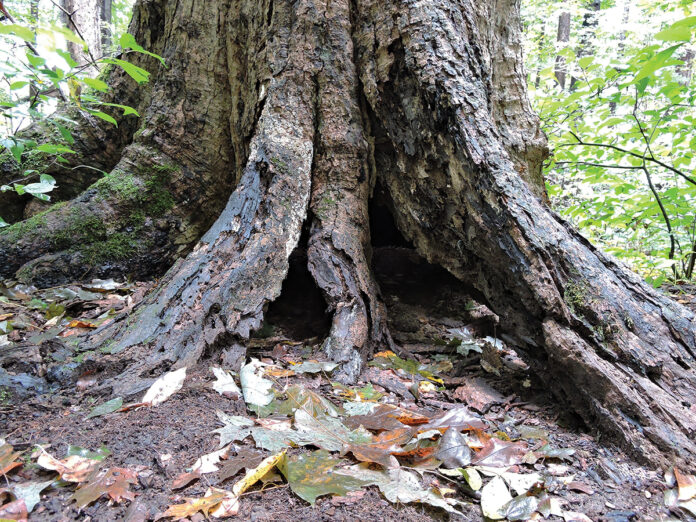
I can’t seem to make it past a hollow tree without stopping to snoop. If there is a cavity within reach, an investigation is in order — evidence of food items on the ground, wear and tear around a hole or simply sounds from within tattle on the tenants inside. One of my favorite tricks is to power up my camera, flash on, and poke it inside the hole for a quick snap.
My most memorable and rewarding discovery using this method came while lying on my stomach at the hollow base of a huge, dead maple. Can you imagine my surprise when I checked my camera to find two downy turkey vulture chicks staring back at me?!
This discovery resulted in three years of intimate trail camera footage of the vulture pair rearing young in this giant tree’s care. Needless to say, I have gained a lifetime of respect and adoration for this species as a result of this experience.

Beauty
I suppose when it comes to dead trees, beauty is in the eye of the beholder. I often catch my breath when I see the striking silhouette of an expired giant. For many, however, once they pass, trees become an eyesore, and I have argued repetitively on the benefits of leaving such trees alone.
Certainly, if the tree poses a hazard, it should be removed. But allowing a dead tree to remain, to give it a chance to finish out its natural cycle, is where the real reward ensues, especially for wildlife.
Purpose
Some tree species, such as sycamore and beech, already have cavities that formed naturally such as hollow trunks or knotholes. These abodes are quickly snatched up by a variety of wildlife such as bats, barred owls, honey bees, wood ducks and raccoons. But the real excavations begin when wildlife decides to utilize the tree as a potential nest site.
These primary cavity nesters, such as woodpeckers and nuthatches, work tirelessly to excavate cozy caverns in the punky wood in which to raise a family. In turn, their holes, which occupy varying heights and come in a variety of sizes, are snatched up by a plethora of secondary nesters that utilize them when they become vacant. Thus, the entire tree can be likened to that of an apartment building, with a different tenant on each floor.
American kestrels, black-capped chickadees, eastern bluebirds, screech owls and great-crested flycatchers, to name a few, are among the species of birds that rely on pre-existing cavities. Several species of squirrels find these excavations convenient for rearing their young.
The arboreal black rat snake, reaching lengths of up to 6 feet, is a regular visitor to hollow trees, either waiting patiently in the shadows for an unsuspecting prey item to enter, or to feed on tenants’ eggs and youngsters that it has so efficiently “sniffed” out.
At the onset of autumn, cavity nesters have completed their family duties, freeing up space for a new cast of wildlife species to stake their claim for the winter months. Southern flying squirrels busy themselves adding layers of leaves to their nests, while raccoons snatch up the larger cavities. White-footed mice make themselves comfortable in the tiniest of holes while groundhogs burrow beneath the decaying roots where hibernation takes over until spring.
Giving back
When a hollow tree eventually falls to the earth, its horizontal remains continue to provide shelter for arthropods, moles, shrews, reptiles, amphibians, skunks, opossums and other animals that are not as adept at climbing. Larger hollow logs or trees with sizable cavities at their base are highly sought after by black bears. After spending the autumn months gorging themselves in preparation for hibernation, bears carefully select a cavity that will provide proper shelter for them as they slumber through winter.
From the time a tree germinates from a tiny seed to the moment that it returns to the soil to aid in the growth of yet another, it benefits living things. A live tree has much to offer and its advantages are many. But to say that its time is up when it finally passes is a sore misjudgment.
The skeleton of a dead tree, silently standing in the forest, littered with holes, may seem like a sorry sight to some. Yet, any time of the year, any minute of the day, it is teeming with life. Without hollow trees, wildlife would certainly suffer.
Suffice it to say, the number of animals a tree benefits after it dies might just be greater than what it did when alive. Profoundly, a hollow tree might just be more alive in death than it was in life!











